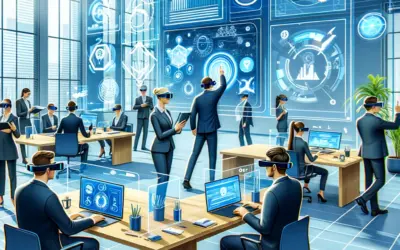1. The Benefits of Virtual Worlds in Corporate Learning: How They Transform Employee Training
The use of virtual worlds in corporate learning has emerged as a game-changer, revolutionizing the traditional approach to employee training. With their immersive and interactive nature, virtual worlds offer a host of benefits that greatly enhance the learning experience and, ultimately, transform employee training.
Enhanced Engagement and Retention
One of the key benefits of virtual worlds in corporate learning is the heightened engagement they provide. By creating a realistic and interactive environment, employees are more actively involved in the learning process. This high level of engagement leads to a greater level of information retention. Virtual worlds stimulate multiple senses, allowing employees to absorb information through visual cues, auditory input, and hands-on experiences. This multi-sensory approach ensures that employees remember what they have learned for a longer period of time.
Safe and Risk-Free Practice
Virtual worlds also offer a safe and risk-free environment for employees to practice skills and apply knowledge. In certain industries, such as healthcare or manufacturing, mistakes can have serious consequences. Virtual simulations allow employees to practice in a controlled setting where errors do not have real-life consequences. This enables employees to learn from their mistakes, refine their skills, and gain confidence without the fear of detrimental outcomes. By providing a risk-free space for experimentation and practice, virtual worlds foster a supportive learning environment.
Collaboration and Team Building
Virtual worlds promote collaboration among employees, regardless of their physical location. Through virtual team-building activities and simulations, employees can work together on projects, solve problems, and develop essential teamwork skills. Whether it’s a virtual team-building exercise or a simulation that requires collective decision-making, virtual worlds offer a platform for employees to collaborate and develop strong working relationships. This virtual collaboration ultimately translates to improved teamwork and communication in the workplace.
Customizable Learning Experiences
Virtual worlds provide the flexibility to customize learning experiences to suit the needs of both individual employees and the organization as a whole. Training scenarios can be tailored to specific job roles, allowing employees to practice skills that directly relate to their day-to-day responsibilities. Furthermore, virtual worlds offer the opportunity to create challenging and realistic scenarios that mimic real-life situations. This customization ensures that employees receive focused training that is relevant to their roles and enables them to develop the necessary skill set for success.
In conclusion, virtual worlds have a profound impact on corporate learning by transforming employee training. The heightened engagement, safe practice environment, collaboration opportunities, and customizable learning experiences offered by virtual worlds empower employees to acquire knowledge and skills effectively. As organizations continue to recognize the immense benefits of virtual worlds, they can revolutionize their training programs and unlock the full potential of their workforce.
2. Incorporating Virtual Worlds into Corporate Learning: A Step-by-Step Guide for Success
In today’s digital age, corporate learning has evolved beyond the traditional classroom setting. As technology continues to advance, businesses are exploring new avenues to engage and educate their employees. One such avenue that has gained significant popularity is the incorporation of virtual worlds into corporate learning.
Why Virtual Worlds?
Virtual worlds provide a unique and immersive learning experience for employees. By simulating real-life scenarios, employees can gain practical skills and knowledge in a safe and controlled environment. This not only enhances their learning but also allows them to apply their learning to real-life situations more effectively. Moreover, virtual worlds offer flexibility, allowing employees to access training programs from anywhere, at any time.
A Step-by-Step Guide
So, how can organizations successfully incorporate virtual worlds into their corporate learning programs? Here’s a step-by-step guide:
- Set clear learning objectives: Before diving into virtual worlds, it’s essential to define the learning objectives you want to achieve. Identify the specific skills or knowledge gaps that need to be addressed through virtual learning.
- Select the right platform: There are numerous virtual world platforms available, each offering different features and functionalities. Consider factors such as ease of use, technical requirements, and scalability to select the platform that aligns with your organization’s needs.
- Create engaging content: Virtual worlds provide an opportunity to design interactive and engaging learning modules. Incorporate multimedia elements, including videos, quizzes, and simulations, to make the learning experience more dynamic and enjoyable for employees.
- Provide guidance and support: While virtual worlds offer self-paced learning, it’s crucial to provide employees with guidance and support. Assign mentors or trainers who can answer questions, provide feedback, and ensure employees stay on track with their learning progress.
Key Benefits and Considerations
Integrating virtual worlds into corporate learning brings several benefits. Firstly, it enhances retention and knowledge transfer as employees actively participate in learning activities. Secondly, virtual worlds foster collaboration and teamwork, allowing employees to interact with each other and learn from shared experiences. Lastly, virtual worlds can be cost-effective in the long run, reducing the need for physical training facilities and travel expenses.
However, organizations should consider a few factors before implementing virtual worlds into corporate learning. Ensure that employees have access to the necessary hardware and software requirements. Conduct regular assessments and evaluations to measure the effectiveness of the virtual learning programs. Lastly, consider data privacy and security concerns and implement appropriate measures to protect sensitive information.
In conclusion, incorporating virtual worlds into corporate learning can revolutionize how organizations educate their employees. By following this step-by-step guide and considering the key benefits and considerations, businesses can establish successful virtual learning programs, resulting in improved employee skills, performance, and overall organizational growth.
3. Enhancing Employee Engagement: Exploring the Role of Virtual Worlds in Corporate Training
In today’s dynamic business landscape, employee engagement is crucial for the success of any organization. With the rapid advancements in technology, companies are constantly searching for innovative approaches to enhance their training programs. Virtual worlds have emerged as a promising tool in corporate training, offering a unique and immersive learning experience.
The Benefits of Virtual Worlds in Corporate Training
Virtual worlds provide employees with a realistic and interactive environment to learn and develop new skills. Unlike traditional training methods, virtual worlds allow employees to actively participate in simulated situations, enhancing their engagement and knowledge retention. Research has shown that when employees are engaged in their learning process, they are more motivated and productive in their work.
One of the key advantages of virtual worlds is the ability to provide hands-on training in a safe and controlled environment. Employees can practice complex tasks and scenarios without the fear of making mistakes that could have real-world consequences. This not only boosts their confidence but also enables them to gain practical experience that can be directly applied to their job roles.
How Virtual Worlds Drive Employee Engagement
Virtual worlds offer a compelling and immersive learning experience that captures employees’ attention and encourages active participation. The interactive nature of virtual environments promotes collaboration and teamwork, fostering a sense of belonging among employees. By working together to solve challenges and complete tasks, employees feel a greater sense of camaraderie and engagement.
Additionally, virtual worlds allow for personalized learning experiences. Each employee can progress through the training program at their own pace, focusing on areas that are most relevant to their individual roles and skill gaps. This tailored approach not only enhances engagement but also ensures that training is effective and impactful.
Overcoming Challenges and Driving Adoption
Despite the numerous benefits, the adoption of virtual worlds in corporate training may face some challenges. The initial investment in technology and infrastructure, as well as the need for specialized training and support, can be perceived as barriers. However, companies can overcome these challenges by starting with small pilot programs and gradually expanding their virtual training initiatives.
Furthermore, companies should actively communicate the advantages of virtual worlds to employees. By highlighting the benefits, such as increased engagement, practical skill development, and personalized learning experiences, organizations can generate enthusiasm and support for the adoption of this innovative training tool.
In conclusion, virtual worlds have shown great potential in enhancing employee engagement in corporate training. By providing a realistic and immersive learning experience, virtual worlds promote active participation, collaboration, and personalized learning. While there may be initial challenges in adopting this technology, the long-term benefits outweigh the investment. As organizations embrace virtual worlds, they open doors to new opportunities for training and development, ultimately leading to a more engaged and skilled workforce.
4. Gamification and Virtual Worlds: A Winning Combination for Effective Corporate Learning
Corporate learning has evolved significantly in recent years, with organizations constantly looking for innovative ways to engage and train their employees. One approach that has gained immense popularity is the use of gamification combined with virtual worlds. This powerful combination has proven to be highly effective in enhancing learning outcomes and driving employee engagement.
By incorporating gamification elements, such as leaderboards, badges, and rewards, into corporate training programs, organizations can tap into the intrinsic motivation of employees. Gamification creates a competitive and goal-oriented environment that encourages employees to actively participate and strive for success. This not only improves their knowledge retention but also fosters a sense of accomplishment, boosting their morale and motivation levels.
Enhanced Learning Experience through Immersive Virtual Worlds
Virtual worlds take corporate learning to a whole new level by providing immersive and interactive experiences. With virtual reality (VR) and augmented reality (AR) technologies, employees can engage in simulations and scenarios that closely resemble real-life situations. This hands-on approach allows them to apply their knowledge in a practical setting, making the learning experience more meaningful and memorable.
Whether it’s practicing essential skills, facing challenging scenarios, or collaborating with virtual counterparts, virtual worlds offer a safe space for employees to learn from their mistakes and develop problem-solving abilities. The use of virtual worlds also eliminates geographical constraints, making it easier for organizations to provide consistent training experiences to their globally distributed workforce.
Measurable Results and Continuous Improvement
One of the key advantages of gamification and virtual worlds in corporate learning is the ability to track and measure progress. Organizations can collect data on employee performance, engagement levels, and knowledge retention, allowing them to identify areas for improvement and tailor training programs accordingly. This data-driven approach enables companies to make informed decisions and optimize their learning strategies to achieve better results.
Furthermore, gamification and virtual worlds offer opportunities for continuous learning and ongoing development. With the ability to provide immediate feedback, personalized learning paths, and adaptive content, organizations can deliver customized training experiences that cater to individual needs and preferences. This not only ensures that employees remain engaged but also facilitates their professional growth and skill enhancement.
In conclusion, gamification and virtual worlds have emerged as a winning combination in the realm of effective corporate learning. By leveraging these strategies, organizations can create engaging and immersive learning experiences that drive employee motivation, enhance knowledge retention, and ultimately boost performance. As technology continues to advance, the potential for gamification and virtual worlds in corporate learning is endless, promising even more exciting and impactful training opportunities in the future.
5. Virtual Reality in Corporate Training: Unleashing the Potential of Virtual Worlds
Virtual Reality in Corporate Training: Unleashing the Potential of Virtual Worlds
Virtual reality (VR) is transforming the way corporate training is conducted by simulating real-world scenarios in immersive environments. This innovative technology has immense potential to revolutionize employee training and development, offering a wide range of benefits that traditional training methods cannot match.
One of the key advantages of using VR in corporate training is its ability to provide a realistic and engaging learning experience. By creating virtual worlds that replicate real-life situations, employees can practice and refine their skills in a controlled environment. Whether it’s a sales pitch or a critical decision-making scenario, VR allows employees to experiment and learn from their mistakes without any real-world consequences.
Additionally, VR in corporate training offers the advantage of scalability and cost-effectiveness. Traditional training methods often involve expensive equipment or hiring specialized trainers. With VR, companies can create training modules that can be accessed anytime, anywhere, eliminating the need for physical training rooms or travel expenses. This not only saves costs but also allows for consistent and standardized training across all employees.
Enhancing Collaboration and Communication
VR in corporate training also fosters collaboration and communication among employees. By creating shared virtual spaces, teams can work together on projects or simulations, even if they are geographically dispersed. This not only promotes teamwork but also improves problem-solving skills by encouraging employees to collaborate and find solutions collectively.
Another aspect where VR shines in corporate training is in improving employee confidence and reducing performance anxiety. By providing a safe and realistic environment, employees can practice their skills repeatedly until they feel comfortable and confident. This boosts their self-assurance and ensures they are well-prepared to handle real-life situations in the workplace.
Conclusion
In conclusion, the integration of virtual reality in corporate training has immense potential to transform the way organizations train their employees. The realistic and immersive learning experiences offered by VR not only improve skills but also enhance collaboration, reduce costs, and boost employee confidence. As more companies embrace this innovative technology, virtual reality is set to revolutionize corporate training and unleash the full potential of virtual worlds.
6. Overcoming Barriers: Implementing Virtual Worlds in Corporate Learning Programs
Overcoming Barriers: Implementing Virtual Worlds in Corporate Learning Programs
Virtual worlds have emerged as a powerful tool in corporate learning programs, especially when it comes to employee training and development. With the ability to simulate real-life scenarios and provide immersive experiences, virtual worlds offer unique opportunities for learners to acquire skills and knowledge in a highly interactive and engaging manner. However, despite their potential benefits, there are several barriers that organizations must navigate to successfully implement virtual worlds in their corporate learning initiatives.
1. Technological Infrastructure
One of the main challenges in implementing virtual worlds is the need for a robust technological infrastructure. Virtual worlds require significant computing power and a stable internet connection to function optimally. Organizations need to ensure that their network can support the bandwidth requirements and provide seamless access to virtual learning environments. Investing in high-performance servers and reliable IT infrastructure is crucial to overcome this barrier.
2. Cost
Implementing virtual worlds in corporate learning programs can be expensive, particularly when it involves developing custom content and maintaining the virtual environment. Organizations need to consider the costs associated with software licensing, hardware upgrades, and hiring skilled professionals who can create and manage virtual learning experiences. Despite the initial investment, organizations must weigh the benefits and potential return on investment that virtual worlds can bring to their training programs.
3. Change Management
Introducing virtual worlds into corporate learning programs requires a culture shift within the organization. Resistance to change is a common barrier that organizations need to address. Employees may be apprehensive about adopting new technologies or feel overwhelmed by the learning curve associated with navigating virtual worlds. Organizations must provide adequate training, clear communication, and ongoing support to help employees understand the benefits of virtual worlds and overcome any reluctance they may have.
In conclusion, implementing virtual worlds in corporate learning programs can be a transformative approach to training and development. However, organizations must overcome various barriers such as technological infrastructure, cost, and change management. By addressing these challenges effectively, organizations can unlock the full potential of virtual worlds to enhance employee learning experiences and drive business success.
7. Virtual Worlds Vs. Traditional Training: The Future of Corporate Learning
Virtual Worlds Vs. Traditional Training: The Future of Corporate Learning
Benefits of Virtual Worlds
In recent years, Virtual Worlds have gained significant traction in the world of corporate learning. Offering a unique and immersive learning experience, virtual worlds provide employees with the opportunity to learn in a simulated environment. One major benefit of virtual worlds is the ability to engage employees in hands-on training that closely resembles real-life scenarios. By simulating realistic situations, employees can practice and develop their skills in a safe and controlled environment. This not only enhances learning retention but also boosts confidence and prepares employees for real-world challenges.
Another advantage of virtual worlds is the flexibility they offer. Unlike traditional training methods, which often require employees to attend a physical location at a specific time, virtual worlds allow for self-paced learning. Employees can access training materials and participate in virtual learning sessions at their own convenience, eliminating scheduling conflicts and travel expenses. This flexibility makes virtual worlds an attractive option, especially for organizations with a geographically dispersed workforce.
Drawbacks of Traditional Training
While traditional training methods have been widely used for years, they do come with certain limitations. One key drawback of traditional training is the lack of engagement. Lectures and presentations can sometimes be monotonous, resulting in reduced employee interest and knowledge retention. Additionally, traditional training methods may not provide employees with the opportunity to practice and apply their skills in real-life scenarios, limiting their ability to translate theoretical knowledge into practical expertise.
Another major drawback is the cost associated with traditional training. Hosting training sessions at physical locations requires renting space, providing materials, and potentially hiring instructors or speakers. These expenses can quickly add up, especially for organizations with a large workforce. Additionally, traditional training often involves travel costs for employees who need to attend off-site training sessions. Considering these financial implications, it’s no wonder that many organizations are exploring more cost-effective alternatives like virtual worlds.
The Future of Corporate Learning
As the corporate landscape continues to evolve, the future of corporate learning is undoubtedly shifting towards virtual worlds. By providing employees with an interactive and engaging learning experience, virtual worlds not only enhance knowledge retention but also allow for practical application of skills. This, in turn, improves employee performance and productivity.
Furthermore, advancements in technology, such as virtual reality and augmented reality, are making virtual worlds even more immersive and realistic. These emerging technologies have the potential to revolutionize corporate learning by creating more authentic and memorable training experiences. With the ability to replicate real-life scenarios, virtual worlds offer a dynamic and engaging learning environment that traditional methods simply cannot match.
In conclusion, virtual worlds are rapidly emerging as the future of corporate learning. With their advantages in engagement, flexibility, and cost-effectiveness, virtual worlds provide organizations with a powerful tool to train and develop their employees. As technology continues to advance, the possibilities for virtual worlds in corporate learning are endless. It’s clear that the future of corporate learning lies within virtual worlds, and organizations would be wise to embrace this innovative method to stay ahead in a rapidly changing business landscape.













0 comentarios